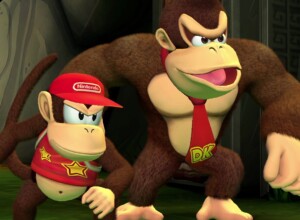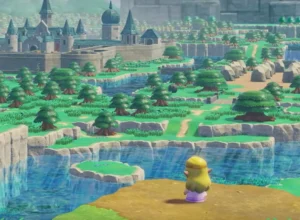Rime is one of the most anticipated video games – indie or otherwise – of the past few years. Does it live up to the hype?
Rime is an unusual thing, in video game terms. It’s an indie game, from a small publisher, but it carries intense anticipation. It wowed audiences wherever it was shown but, other than its beautiful, painterly visual style, we didn’t know all that much about it. It’s even graced the cover of Edge magazine. Twice.
Most AAA games from publishers like Ubisoft and EA don’t get more than one shot at the front cover of Edge. Rime received top billing on Edge #273, back in Winter 2014, and again on Edge #305, in May’s issue this year.
It’s kind of a big deal; Josh certainly thought so when he previewed it at the beginning of the month. But now it’s here, does it live up to its billing as an indie industry darling, punching well above its weight?
The beginning of Rime is, as it happens, both incredibly special and rather rote.
You play as a young child, washed up on the shores of mysterious island. No preamble, no exposition; just a mouthful of sand, saltwater and stupefaction. It feels like so much of what we’ve seen and experienced before, from The Bourne Identity to Link’s Awakening, with a heavy side-helping of The Witness. This is fugue state 101, but Rime handles it with a style and charm that really sets it apart.
The important thing to remember here is that you’re in the shoes – metaphorically speaking; our protagonist is barefoot – of a child. Age isn’t important. Background doesn’t matter. Gender is of no consequence. This is a small child, adrift in a world dripping with wonder, charm bursting from every angle.
The first thing I did was pretty standard small child behaviour: I ran at a group of seagulls, who promptly scattered, chattering, before settling back down on another part of the beach. Crabs wandering on the sand would dig themselves into safe little burrows to avoid being trodden on. I waded out to my waist in the crystal waters of the calm ocean, which turned into a gentle swim, which became a glorious bob and splash around an idyllic holiday cove.
This feels magic.
I swam out for a hundred metres or more before I ran into a ring of jelly fish, preventing me from escaping the cove and discovering other parts of the island in the wrong order. They voicelessly ushered me back to shore, pushing me forward against the soft lapping of the ocean and the gentle, soothing score. At times Rime feels unenclosed and accessible, and has the trappings of open world games, but I was definitely being funnelled up the beach.
Rime then continues to gingerly push you towards solutions to playful, island-themed puzzles, which will definitely come in handy in the latter stages. Strange as it sounds, using tropical fruit to guide wild boar (and their adorable, humbug babies) to where you need them to be – or not, as the case may be – is a transferrable skill you’ll need to know later.
Most of the puzzle solving in Rime, though, is ultimately split into three discrete skills:
- Climbing and environment traversal, Uncharted style.
- Pushing objects around to climb on or fit other puzzles, Uncharted style.
- Manipulating switches and keys, Uncharted style.
Many of the puzzles revolve around manipulating light and shadow on different sensors, for example, and one of the objects you can push around is a moon-like ball that physically changes the time of day to adjust these puzzles. It’s an incredibly effective but simple mechanic that keeps you on your toes. But other than a few standout examples it’s pretty standard puzzle-platform fare, somewhere between the aforementioned Uncharted series’ tomb raiding and 2015’s lovely-but-repetitive Submerged.
Mercifully, Rime is short enough (around six hours) that the puzzles never really get chance to grate, and the presentation and feel – a love letter to Studio Ghibli via Team Ico – hold the player’s interest more than the gameplay.
Tequila Works certainly wear those influences on their sleeve. The child shouts at switches to activate them, a pitiful little yap from a lost urchin. It’s hard not to be reminded of the boy shouting at Trico in The Last Guardian, and then you meet the fox, one of the real stars of Rime.
You shout at a number of fox statues, scattered around the open sandbox area, the game’s beginning chapter, and once they’re all activated a larger fox statue brings your companion to life. He’s adorable, beautifully animated, and incredibly sympathetic to the child’s plight. The fox effervesces, bounding around the environment, guiding you where to go and barking encouragement – echoing the child’s tiny voice – to point you wordlessly towards the solution.
That’s the first couple of hours of Rime and they are, without overstating this, an unbridled joy.
And then everything changes when you reach the tower. The wide open Mediterranean environments, ripped straight from a Joaquin Sorolla painting and jammed through Unreal Engine with some gorgeous, stylistic shaders, give way to claustrophobic internal environments and bumbling around in the dark.
One section, where you have to yelp at torches to light the way on a raised labyrinth in a pitch black room, is particularly frustrating; not least because you’ll fall off and, unusually for gentle puzzle games, you can die in Rime.
And in the subsequent section you will die a lot, harried by a giant bird of prey – a vicious, skull-headed Songbird-alike, plucking you from the sky if you don’t solve a puzzle or find cover quickly enough – or running out of air in submerged shrines. It’s tough and feels unfair, a throwback to scrolling screen levels in platformers of yore.
Soon after you’ll be in the ruins of the tower again, running from Dementor-like hooded figures, whispering in sinister fashion from a distance. Get too close and they’ll drain your life, ultimately killing a frightened child in the pitch black of the tower. Rime gets really dark, really quickly.
And this is the bit where this review gets really difficult. We don’t put spoilers in reviews here at Thumbsticks – house rules – but that makes this review incredibly tough to finish. While I loved the first couple of hours of Rime, and a few of the middle-to-late segments of the game are full of charm and intrigue as the child makes some unexpected friends in the gloom of the tower, the ending upset me immensely.
Just imagine, if you will, there’s another dozen paragraphs in this space here, explaining why I found it so distressing. There’s another article which covers the vagaries of what happens towards the end of Rime – and why it upset me so much – right here. Be warned; it is crammed to the rafters with spoilers. Seriously. Stay away if you want to keep what happens in Rime a secret.
But without that other, spoiler-filled article, I can’t adequately convey to you why I don’t recommend Rime. If we were to do the terrible video game journalism thing of the mid-nineties and break it down into its component parts – amazing presentation; gorgeous soundscapes; stunning opening; rote puzzles; dire middle third; intriguing final act; and an ending that ultimately upset me immensely – you might decide that, on balance, it’s worth playing.
But in reality, the emotional gut-punch delivered by Rime is up there with The Beginner’s Guide and That Dragon, Cancer, and I simply didn’t see that coming. I certainly wasn’t prepared for it when I started playing what I thought was a cheery little island-hopping puzzle platformer, and it ultimately left me feeling hollow and horrified.
For Rime, I don’t know if Tequila Works set out with the idea for the game – a beautifully-crafted and stylish island puzzle adventure, albeit one that is a little repetitive and derivative once you get past its stunning visuals – or the poignant but ultimately distressing story that goes with it. This is an experience that’s meant to be deep and thought-provoking, but the conclusion is such a harrowing rug pull that it genuinely left me feeling distressed.
With that in mind, I don’t feel I can’t score Rime in the ‘usual’ way. I’ve been wrestling with this for days, and I honestly don’t know how to do it fairly, so I’m going to have to split the score.
For the ‘game’ components; the visuals, sound and gameplay:
4/5
For the story, and how bloody terrible the ending made me feel:
0.5/5
I’m sorry. I know that’s confusing, but it’s genuinely the best I could come up with.






